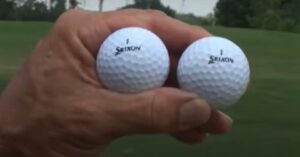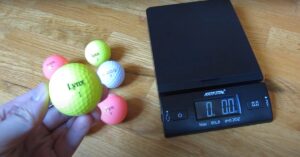What Are The Numbers On Golf Balls: The Role Of Numerical Markings
Have you ever wondered what those numbers on golf balls mean? If so, you’re not alone. Many golfers are curious about the significance of these numbers, but they may not know where to find the answer.
The numbers on golf balls can have different meanings, depending on the type of number. Single-digit numbers are typically used for identification purposes, while two-digit numbers can indicate the compression rating of the ball. Three-digit numbers can indicate the number of dimples on the ball.
In this post, we’ll explore what the numbers on golf balls mean and how they can impact your performance on the course.
What Do The Numbers On The Golf Balls Mean?

These numbers serve a purpose and provide useful information to golfers. Learning what these numbers mean can help you make better decisions on the course and improve your game.
Let’s explore the significance of the numbers on golf balls.
Golf Ball Numbers
The numbers on golf balls typically range from 1 to 10 and are usually found on the side or near the brand logo. These numbers are used to identify different types of golf balls and indicate their specific characteristics. While the exact meaning of the numbers can vary between manufacturers, here are the general guidelines
Compression Rating
The number on a golf ball can indicate its compression rating, which refers to the ball’s density. A lower compression rating, such as 70, signifies a softer ball that compresses more easily upon impact. These balls are suitable for players with slower swing speeds as they offer more distance. Conversely, higher compression balls, like 100, are firmer and provide greater control and distance for players with faster swing speeds.
Construction
The numbers on golf balls may also reflect the construction or layers of the ball. Multi-layered balls, such as three-piece or four-piece balls, are designed to provide different performance attributes. These balls often have higher numbers like 3, 4, or 5. They offer a balance of distance, control, and feel, making them suitable for a wide range of players.
Dimple Pattern
The numbers on golf balls can sometimes represent the dimple pattern used on the ball’s surface. Dimple patterns affect the ball’s aerodynamics, trajectory, and spin control. Manufacturers may assign specific numbers to indicate variations in dimple patterns, helping golfers identify which ball suits their playing style.
Brand Differentiation
In some cases, golf ball numbers are simply used for brand differentiation. Each golf ball manufacturer assigns unique numbers to their products to distinguish themselves from competitors. These numbers may not have a specific significance beyond helping players identify the brand and model of the ball.
How Golf Ball Numbers Affect Performance And Spin

Golf ball numbers play a crucial role in determining the performance and spin of the ball during gameplay. Here, we will explore how golf ball numbers influence performance and spin, providing you with valuable insights to enhance your golfing experience.
Choosing The Right Golf Ball
When selecting a golf ball, it’s important to pay attention to the numbers on the packaging. These numbers typically refer to the compression and the number of layers the ball possesses. The two most common numbers you’ll encounter are the compression rating and the layer count.
Compression Rating
The compression rating of a golf ball affects its feel and performance. It is usually denoted by a number ranging from 0 to 200. Low-compression balls (below 70) are softer and more forgiving on slower swing speeds, offering greater distance for players with less power. Higher compression balls (above 90) are firmer and provide better control for faster swing speeds, making them ideal for professional players.
Layer Count
The layer count of a golf ball refers to the number of layers within the ball’s construction. Typically, golf balls come in two-layer, three-layer, or four-layer constructions. Each additional layer adds complexity and can impact the ball’s performance.
Two-Layer Balls
Two-layer golf balls are usually designed for beginners or golfers seeking maximum distance. They offer a soft feel and are known for their low spin rate. These balls provide straighter shots and are more forgiving on off-center hits.
Three-Layer Balls
Three-layer golf balls strike a balance between distance and control. The outer layer is usually softer, providing an enhanced feel, while the inner layers help generate spin and control during approach shots and around the green. These balls are suitable for a wide range of players, from intermediate to advanced.
Four-Layer Balls
Four-layer golf balls are designed for advanced players looking for maximum control and spin. The multiple layers contribute to increased spin rates and better performance in windy conditions. These balls are often preferred by professionals or low-handicap players.
Understanding Spin
The spin of a golf ball significantly affects its trajectory and overall performance. High spin balls tend to curve more in flight, making them ideal for skilled players who can control and shape their shots. On the other hand, low spin balls provide more distance and a straighter flight, suiting golfers with higher swing speeds.
Matching Golf Ball To Your Game
To optimize your performance, it’s essential to match the golf ball to your playing style and skill level. If you’re a beginner, a softer two-layer ball might be the right choice, focusing on distance and forgiveness.
Intermediate players may benefit from a three-layer ball, offering a balance between distance and control.
Advanced players and professionals can opt for a four-layer ball, prioritizing control and spin.
Matching Golf Ball Numbers To Player Skill Levels

The numbers on golf balls can be a confusing topic for many golfers. However, understanding these numbers can help you choose the right ball for your game.
Here, we will discuss how to match golf ball numbers to player skill levels.
- Single-digit numbers- These numbers are used for identification purposes. Golfers can use different numbers to distinguish their balls from others on the course.
- Two-digit numbers- These numbers indicate the compression rating of the golf ball. Compression rating is a measure of how soft or hard the ball is. Lower compression ratings are better for golfers with slower swing speeds, while higher compression ratings are better for golfers with faster swing speeds.
- Three-digit numbers- These numbers indicate the number of dimples on the golf ball. Dimples help to reduce drag and create lift, which can improve the ball’s flight.
How to Match Golf Ball Numbers to Player Skill Levels
The first step to matching golf ball numbers to player skill levels is to determine your swing speed. You can do this by using a golf launch monitor or by asking a golf professional.
Once you know your swing speed, you can then look for a golf ball with a compression rating that is appropriate for your level of play.
For golfers with slower swing speeds, a golf ball with a lower compression rating is a better choice.
These balls will be easier to compress, which will help you to achieve a longer and straighter flight. Golfers with faster swing speeds can benefit from using a golf ball with a higher compression rating.
These balls will provide more distance and spin, which can be helpful for golfers who are looking to improve their accuracy and control.
What to Consider When Choosing a Golf Ball
In addition to compression rating, there are a few other factors that you should consider when choosing a golf ball. These factors include
- Feel- The feel of a golf ball is subjective, but it is generally agreed that softer balls feel better on impact. This is especially important for golfers who are prone to slicing or hooking the ball.
- Spin- Spin can help you to control the flight of your ball, especially on approach shots and putts. Golfers who want more spin should choose a ball with a dimple pattern that is designed to create more lift.
- Durability- Golf balls can take a beating on the course, so it is important to choose a ball that is durable. Look for a ball that has a urethane cover, which is more resistant to scuffs and scratches.
The Best Golf Balls for Different Skill Levels
There are many great golf balls on the market, so it can be difficult to choose the right one for your game. However, here are a few of the best golf balls for different skill levels
- For golfers with slower swing speeds The Srixon Soft Feel is a great option for golfers who are looking for a soft, forgiving ball that will help them to achieve longer and straighter drives.
- For golfers with average swing speeds The Titleist Pro V1 is a popular choice for golfers who are looking for a high-performance ball that offers a combination of distance, spin, and feel.
- For golfers with fast swing speeds The Bridgestone Tour B XS is a great option for golfers who are looking for a ball that will provide maximum distance and spin.
No matter what your skill level is, there is a golf ball out there that is perfect for you. By taking the time to consider your swing speed and other factors, you can choose a ball that will help you to improve your game.
Frequently Asked Questions
When you pick up a golf ball, you might have noticed numbers printed on them. These numbers serve a purpose and provide valuable information to golfers.
Let’s explore some frequently asked questions about the numbers on golf balls.
How Does The Compression Rating Affect My Game?
The compression rating of a golf ball affects its feel and performance. A lower compression ball tends to feel softer and provides more distance for golfers with slower swing speeds. Higher compression balls offer more control and distance for golfers with faster swing speeds.
Are There Any Other Reasons For The Numbers On Golf Balls?
In addition to the compression rating, the numbers on golf balls also help golfers identify their ball during play. Golfers can personalize their balls with a specific number, making it easier to distinguish their ball from others on the course.
Which Number Should I Choose For My Golf Ball?
The choice of number on a golf ball is mostly a personal preference. Some golfers have lucky numbers, while others prefer a specific number for identification purposes. Ultimately, it does not significantly affect the performance of the ball.
Are There Any Rules Or Regulations Regarding The Numbers On Golf Balls?
Golf’s governing bodies, such as the USGA and R&A, have rules regarding the markings on golf balls, including the numbers. The numbers should be clearly visible, legible, and meet the specified size requirements. It’s essential to ensure your golf ball conforms to these regulations for official play.
Conclusion
The numbers on golf balls play a vital role in enhancing your game. They aid in identification, provide personalization options, and help golfers track their shots. Whether you’re a beginner or a seasoned player, understanding the significance of these numbers can improve your overall performance on the greens.


![how many dimples are on a golf ball? [Science behind Dimples] how-many-dimples-are-on-a-golf-ball](https://giftedgolfers.com/wp-content/uploads/2023/01/how-many-dimples-are-on-a-golf-ball-300x157.jpg)


